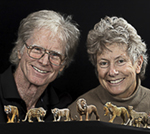Tanzania 2023
February
Trip Report
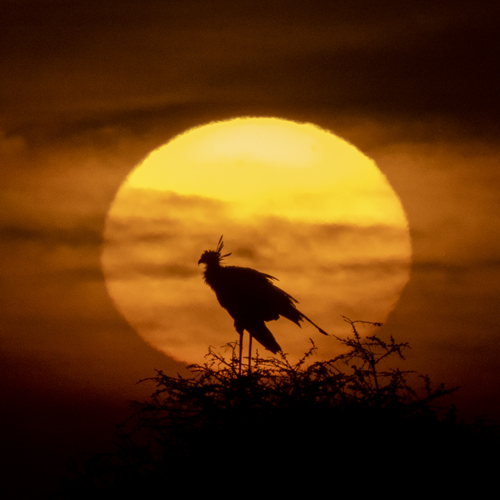
We just returned from our two Photo Safaris to Tanzania's Serengeti and Ngorongoro Crater and we're excited. We can't wait to return. To be honest, before doing this trip both Mary and I thought that this would be our last safari to Tanzania in Februrary. We were thinking of slowing down, and in that slow down Tanzania in February would be one of the victems. However, after doing these trips, we just couldn't justify doing so.
The shooting here is always productive but as we positioned our vehicles for optimal photography we realized that we just had too much information, too much experience, to give this up. I don't want that statement to sound like a brag but with over 4 years worth of field time in East Africa, with scores and scores of safaris, we know the wildlife and how best to get our participants great images. Consequently, we're going to keep doing safaris here, in February and in October.
As I write this I'm also preparing a large portfolio of images I'll be posting, and I'll have a link on this website and on Facebook as soon as it is completed. Hopefully, I'll also expand this Trip Report, so if you're looking at this report in the next few days (March 3, published date), please visit this page again in a week or so.
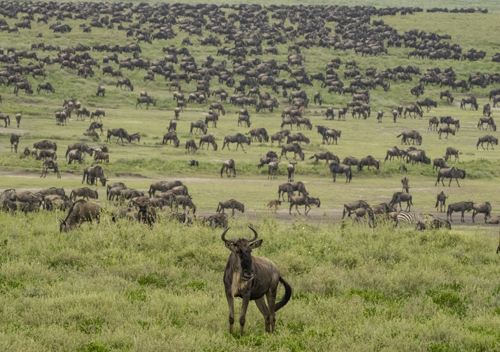
This year's February trips was planned to coincide with the annaul Gnu birthing season. Historically, we've found that peak to be during February, and around the Ngorongoro Crater, mid-month was prime. Not this year! Like the wierd weather much of the US has had this year, disrupting life-cycles and normal patterns, this year the Gnu's peak birthing occured in early and mid-January, about 3 weeks earlier than a normal year. The result -- we saw no births, although in the Crater we missed a few by only a few minutes.
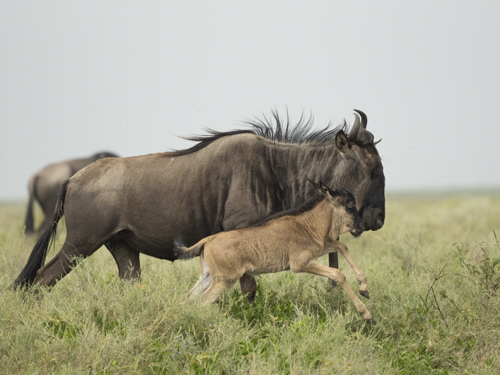
One might not think there would be a big difference between one safari and the next but each one was different, with great highlights in both. On the first safari, when we arrived in the 'prime' birthing grounds, we found that the Gnus were far to the south, almost two hours away. Rain, a driving force for where Gnus will move and graze, led the Gnus elsewhere. When we did a game drive into that area, just touching the edge of the big herds, one of our vehicles got mired in the black cotton soil. When our other vehicle attempted to pull the other out, that one was stuck, too. Fortunately, another vehicle from another company arrived and pulled out the second vehicle, and around 3 hours later our guides finally got the other vehicle free.
Our getting stuck was because of the rain, and nearly every day or during the night we had rain. But this was a good thing, as the herds returned, and on our last days at a camp the herds spread across the plains, from horizon to horizon.
From there we headed to the Crater to conclude the first safari and where we would start the second. In the five days that elapsed before we returned to the southern Serengeti the rains had stopped and the herds moved on. The plains were empty of Gnus, although thousands of Thompson's Gazelles and Plains Zebras were in abundance, but the Gnus ... we finally found the herds as they migrated through woodlands as they headed northward.
Gnu calves often become separated from their mothers, or our orphaned when a Gnu mother is killed, as was the case when a pride of Lions killed a Gnu mother. The baby wandered about, sometimes returning to the pride (still feeding on mom), but the Lions were so stuffed that only one made what can be described as a really half-hearted attempt to capture the calf. The calf escaped.

Later that morning, however, that calf wandered within sight of two male Cheetahs we'd been following earlier in the day. We were there when the Cheetahs chased down the Gnu, and had the cats been at full charge when they passed us we'd have had our best shots, ever, of a running Cheetah. Instead, the cats knew they'd catch the calf and only put on speed when they were quite close the the calf. Even then, however, the calf raced about for quite a stretch before it was captured.
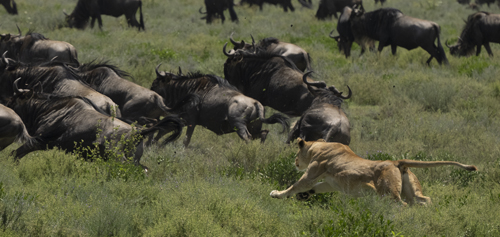
We had at least three other hunts that involved Lions and Gnus, and each time the Lions failed. Some hunts involved adults, and other calfs, and sometimes the lion was within a body length of their prey, yet the Gnu escaped. Most hunts have no more than a 20% success rate, but the cats we were watching were batting zero.
We did extremely well with all the cats -- between the two trips we photographed all of the savannah's cats - African Wild Cat, Serval, Caracal, Cheetah, Leopard, and Lion. We had several tree-climbing Lions, and on the second trip, soon after dawn, a great encounter with a Leopard in a tree, completely in the clear and one of the best ever shoots. A female Leopard we'd seen in October of '22 now had THREE cubs, which we photographed for the first time ever!
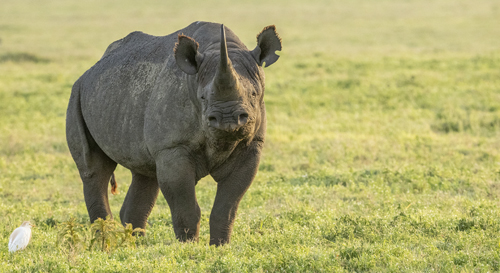
Black Rhinos are always elusive and it isn't uncommon to see this endangered species at a distance, a speck on the floor of the Ngorongoro Crater. This year, both safaris had great photo ops with Black Rhinos in the Crater.
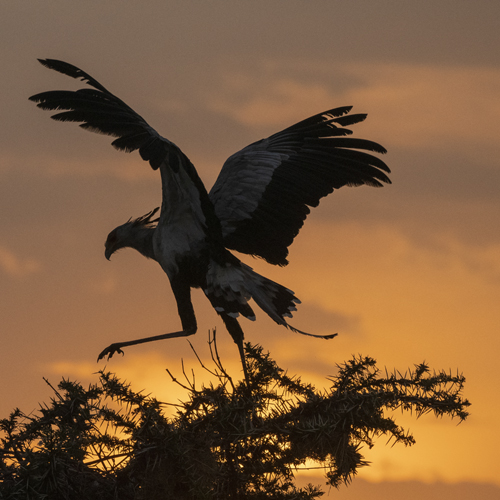
While I'm only showing a few of the birds we photographed, we probably photographed close to 100 species of birds. At dawn we often had Secretarybirds perched on acacias, for great sunrise shoots, and, recognizing the clues, we were in position when this species flew back to the nest with nesting material.
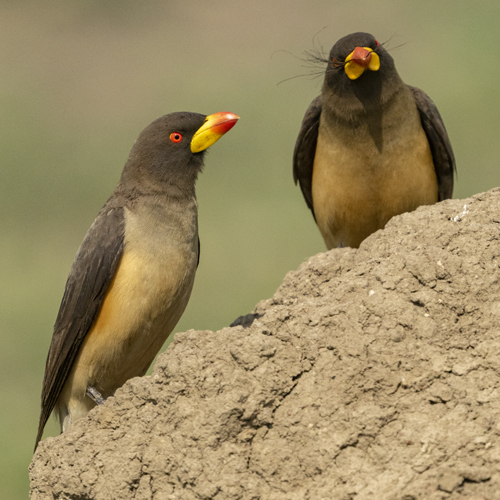
On another occasion, we found a Yellow-billed Oxpecker at a termite mound. At first I thought the bird was looking for insects but as we watched, another Oxpecker joined it, with buffalo hair strands in its beak. The bird disappeared inside the mound, returning a few minutes later without the hairs. It was building a nest ... something our guides in 20+ years of field time had never seen.
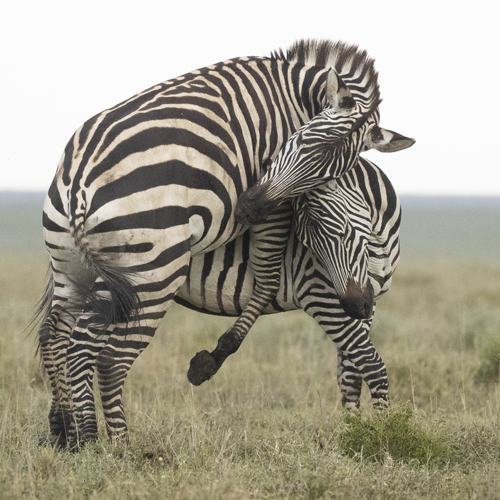
I could go on for pages on all of the encounters and observations, but I'll end here with a small portfolio with captions that tell the story. Hopefully, you'll be motivated to join us in 2024 when we return to Tanzania ... one of the best shoots you'll ever have!
Here's some of the highlights
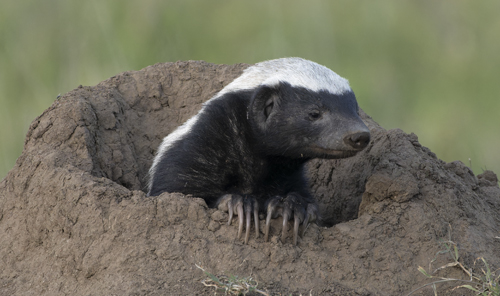
Honey Badger - our guides hadn't seen one in 5 years, and never this close!
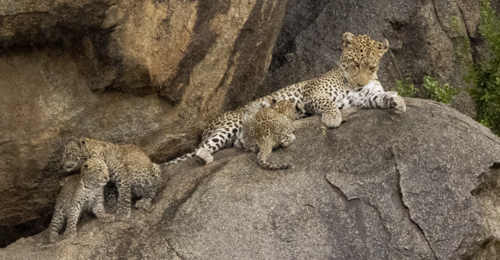
Count the cubs! Three!
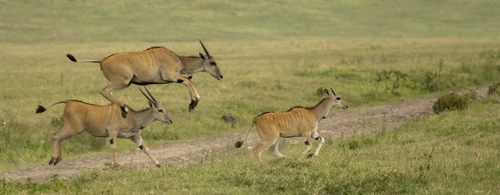
Eland, the largest antelope, are incredible jumpers.
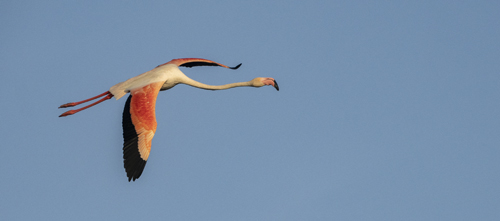
Greater Flamingo
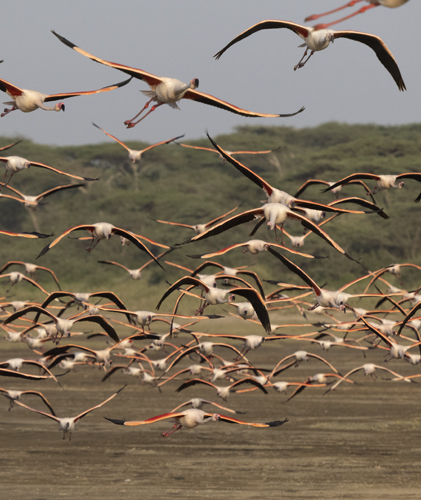
.jpg)
Uncaring tourists flushed this huge flock of Flamingos, but lucky for Mary, her
vehicle was in their flight path as they flew back to the lake.
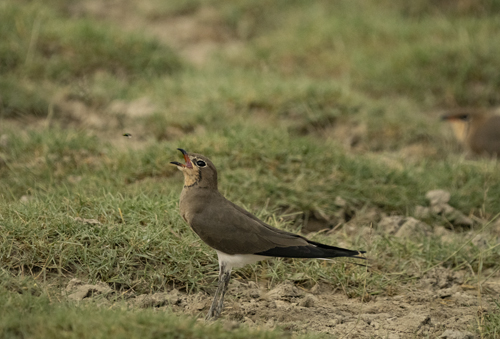
We were watching these Collared Pracincoles jumping
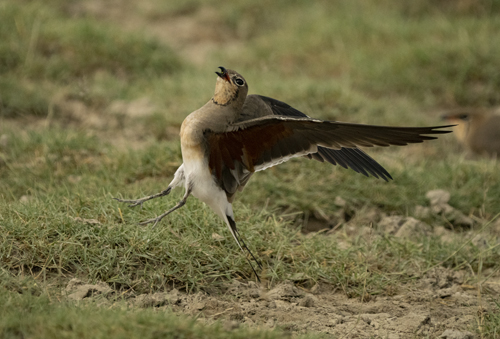
A closer look showed they were catching flies!
There will be more to come!
2020, 2021, 2022, and 2023 Trip Reports
Brazil's Pantanal - north and south 2022
Costa Rica January 2022
Tanzania Photo Safari 2021,
Rwanda's Mountain Gorillas 2021
Kenya Photo Safari, 2021
Puma and the Wildlife of Chile Trip 1
Puma and the Wildlife of Chile Trip 2
Tanzania Februray
Falkland Islands
Interviews
Paws Trails-Mary
Kruger 2 Kruger - Joe
Paws Trails - Joe
ShotKit
Join us on Facebook at: Follow Hoot Hollow
Office Phone: (717) 543-6423
Email us at info@hoothollow.com
Mary and Joe are proud to endorse the Photo Retailer that has
done the absolute most in supporting nature photography in all
its facets ---

Check out the Monthly Specials
from Hunt's
test
Tanzania 2023
February
Trip Report

We just returned from our two Photo Safaris to Tanzania's Serengeti and Ngorongoro Crater and we're excited. We can't wait to return. To be honest, before doing this trip both Mary and I thought that this would be our last safari to Tanzania in Februrary. We were thinking of slowing down, and in that slow down Tanzania in February would be one of the victems. However, after doing these trips, we just couldn't justify doing so.
The shooting here is always productive but as we positioned our vehicles for optimal photography we realized that we just had too much information, too much experience, to give this up. I don't want that statement to sound like a brag but with over 4 years worth of field time in East Africa, with scores and scores of safaris, we know the wildlife and how best to get our participants great images. Consequently, we're going to keep doing safaris here, in February and in October.
As I write this I'm also preparing a large portfolio of images I'll be posting, and I'll have a link on this website and on Facebook as soon as it is completed. Hopefully, I'll also expand this Trip Report, so if you're looking at this report in the next few days (March 3, published date), please visit this page again in a week or so.

This year's February trips was planned to coincide with the annaul Gnu birthing season. Historically, we've found that peak to be during February, and around the Ngorongoro Crater, mid-month was prime. Not this year! Like the wierd weather much of the US has had this year, disrupting life-cycles and normal patterns, this year the Gnu's peak birthing occured in early and mid-January, about 3 weeks earlier than a normal year. The result -- we saw no births, although in the Crater we missed a few by only a few minutes.

One might not think there would be a big difference between one safari and the next but each one was different, with great highlights in both. On the first safari, when we arrived in the 'prime' birthing grounds, we found that the Gnus were far to the south, almost two hours away. Rain, a driving force for where Gnus will move and graze, led the Gnus elsewhere. When we did a game drive into that area, just touching the edge of the big herds, one of our vehicles got mired in the black cotton soil. When our other vehicle attempted to pull the other out, that one was stuck, too. Fortunately, another vehicle from another company arrived and pulled out the second vehicle, and around 3 hours later our guides finally got the other vehicle free.
Our getting stuck was because of the rain, and nearly every day or during the night we had rain. But this was a good thing, as the herds returned, and on our last days at a camp the herds spread across the plains, from horizon to horizon.
From there we headed to the Crater to conclude the first safari and where we would start the second. In the five days that elapsed before we returned to the southern Serengeti the rains had stopped and the herds moved on. The plains were empty of Gnus, although thousands of Thompson's Gazelles and Plains Zebras were in abundance, but the Gnus ... we finally found the herds as they migrated through woodlands as they headed northward.
Gnu calves often become separated from their mothers, or our orphaned when a Gnu mother is killed, as was the case when a pride of Lions killed a Gnu mother. The baby wandered about, sometimes returning to the pride (still feeding on mom), but the Lions were so stuffed that only one made what can be described as a really half-hearted attempt to capture the calf. The calf escaped.

Later that morning, however, that calf wandered within sight of two male Cheetahs we'd been following earlier in the day. We were there when the Cheetahs chased down the Gnu, and had the cats been at full charge when they passed us we'd have had our best shots, ever, of a running Cheetah. Instead, the cats knew they'd catch the calf and only put on speed when they were quite close the the calf. Even then, however, the calf raced about for quite a stretch before it was captured.

We had at least three other hunts that involved Lions and Gnus, and each time the Lions failed. Some hunts involved adults, and other calfs, and sometimes the lion was within a body length of their prey, yet the Gnu escaped. Most hunts have no more than a 20% success rate, but the cats we were watching were batting zero.
We did extremely well with all the cats -- between the two trips we photographed all of the savannah's cats - African Wild Cat, Serval, Caracal, Cheetah, Leopard, and Lion. We had several tree-climbing Lions, and on the second trip, soon after dawn, a great encounter with a Leopard in a tree, completely in the clear and one of the best ever shoots. A female Leopard we'd seen in October of '22 now had THREE cubs, which we photographed for the first time ever!

Black Rhinos are always elusive and it isn't uncommon to see this endangered species at a distance, a speck on the floor of the Ngorongoro Crater. This year, both safaris had great photo ops with Black Rhinos in the Crater.

While I'm only showing a few of the birds we photographed, we probably photographed close to 100 species of birds. At dawn we often had Secretarybirds perched on acacias, for great sunrise shoots, and, recognizing the clues, we were in position when this species flew back to the nest with nesting material.

On another occasion, we found a Yellow-billed Oxpecker at a termite mound. At first I thought the bird was looking for insects but as we watched, another Oxpecker joined it, with buffalo hair strands in its beak. The bird disappeared inside the mound, returning a few minutes later without the hairs. It was building a nest ... something our guides in 20+ years of field time had never seen.

I could go on for pages on all of the encounters and observations, but I'll end here with a small portfolio with captions that tell the story. Hopefully, you'll be motivated to join us in 2024 when we return to Tanzania ... one of the best shoots you'll ever have!
Here's some of the highlights

Honey Badger - our guides hadn't seen one in 5 years, and never this close!

Count the cubs! Three!

Eland, the largest antelope, are incredible jumpers.

Greater Flamingo

.jpg)
Uncaring tourists flushed this huge flock of Flamingos, but lucky for Mary, her
vehicle was in their flight path as they flew back to the lake.

We were watching these Collared Pracincoles jumping

A closer look showed they were catching flies!
There will be more to come!
2020, 2021, 2022, and 2023 Trip Reports
Brazil's Pantanal - north and south 2022
Costa Rica January 2022
Tanzania Photo Safari 2021,
Rwanda's Mountain Gorillas 2021
Kenya Photo Safari, 2021
Puma and the Wildlife of Chile Trip 1
Puma and the Wildlife of Chile Trip 2
Tanzania Februray
Falkland Islands
Interviews
Paws Trails-Mary
Kruger 2 Kruger - Joe
Paws Trails - Joe
ShotKit
Join us on Facebook at: Follow Hoot Hollow
Office Phone: (717) 543-6423
Email us at info@hoothollow.com
Mary and Joe are proud to endorse the Photo Retailer that has
done the absolute most in supporting nature photography in all
its facets ---

Check out the Monthly Specials
from Hunt's
test
Tanzania 2023
February
Trip Report

We just returned from our two Photo Safaris to Tanzania's Serengeti and Ngorongoro Crater and we're excited. We can't wait to return. To be honest, before doing this trip both Mary and I thought that this would be our last safari to Tanzania in Februrary. We were thinking of slowing down, and in that slow down Tanzania in February would be one of the victems. However, after doing these trips, we just couldn't justify doing so.
The shooting here is always productive but as we positioned our vehicles for optimal photography we realized that we just had too much information, too much experience, to give this up. I don't want that statement to sound like a brag but with over 4 years worth of field time in East Africa, with scores and scores of safaris, we know the wildlife and how best to get our participants great images. Consequently, we're going to keep doing safaris here, in February and in October.
As I write this I'm also preparing a large portfolio of images I'll be posting, and I'll have a link on this website and on Facebook as soon as it is completed. Hopefully, I'll also expand this Trip Report, so if you're looking at this report in the next few days (March 3, published date), please visit this page again in a week or so.

This year's February trips was planned to coincide with the annaul Gnu birthing season. Historically, we've found that peak to be during February, and around the Ngorongoro Crater, mid-month was prime. Not this year! Like the wierd weather much of the US has had this year, disrupting life-cycles and normal patterns, this year the Gnu's peak birthing occured in early and mid-January, about 3 weeks earlier than a normal year. The result -- we saw no births, although in the Crater we missed a few by only a few minutes.

One might not think there would be a big difference between one safari and the next but each one was different, with great highlights in both. On the first safari, when we arrived in the 'prime' birthing grounds, we found that the Gnus were far to the south, almost two hours away. Rain, a driving force for where Gnus will move and graze, led the Gnus elsewhere. When we did a game drive into that area, just touching the edge of the big herds, one of our vehicles got mired in the black cotton soil. When our other vehicle attempted to pull the other out, that one was stuck, too. Fortunately, another vehicle from another company arrived and pulled out the second vehicle, and around 3 hours later our guides finally got the other vehicle free.
Our getting stuck was because of the rain, and nearly every day or during the night we had rain. But this was a good thing, as the herds returned, and on our last days at a camp the herds spread across the plains, from horizon to horizon.
From there we headed to the Crater to conclude the first safari and where we would start the second. In the five days that elapsed before we returned to the southern Serengeti the rains had stopped and the herds moved on. The plains were empty of Gnus, although thousands of Thompson's Gazelles and Plains Zebras were in abundance, but the Gnus ... we finally found the herds as they migrated through woodlands as they headed northward.
Gnu calves often become separated from their mothers, or our orphaned when a Gnu mother is killed, as was the case when a pride of Lions killed a Gnu mother. The baby wandered about, sometimes returning to the pride (still feeding on mom), but the Lions were so stuffed that only one made what can be described as a really half-hearted attempt to capture the calf. The calf escaped.

Later that morning, however, that calf wandered within sight of two male Cheetahs we'd been following earlier in the day. We were there when the Cheetahs chased down the Gnu, and had the cats been at full charge when they passed us we'd have had our best shots, ever, of a running Cheetah. Instead, the cats knew they'd catch the calf and only put on speed when they were quite close the the calf. Even then, however, the calf raced about for quite a stretch before it was captured.

We had at least three other hunts that involved Lions and Gnus, and each time the Lions failed. Some hunts involved adults, and other calfs, and sometimes the lion was within a body length of their prey, yet the Gnu escaped. Most hunts have no more than a 20% success rate, but the cats we were watching were batting zero.
We did extremely well with all the cats -- between the two trips we photographed all of the savannah's cats - African Wild Cat, Serval, Caracal, Cheetah, Leopard, and Lion. We had several tree-climbing Lions, and on the second trip, soon after dawn, a great encounter with a Leopard in a tree, completely in the clear and one of the best ever shoots. A female Leopard we'd seen in October of '22 now had THREE cubs, which we photographed for the first time ever!

Black Rhinos are always elusive and it isn't uncommon to see this endangered species at a distance, a speck on the floor of the Ngorongoro Crater. This year, both safaris had great photo ops with Black Rhinos in the Crater.

While I'm only showing a few of the birds we photographed, we probably photographed close to 100 species of birds. At dawn we often had Secretarybirds perched on acacias, for great sunrise shoots, and, recognizing the clues, we were in position when this species flew back to the nest with nesting material.

On another occasion, we found a Yellow-billed Oxpecker at a termite mound. At first I thought the bird was looking for insects but as we watched, another Oxpecker joined it, with buffalo hair strands in its beak. The bird disappeared inside the mound, returning a few minutes later without the hairs. It was building a nest ... something our guides in 20+ years of field time had never seen.

I could go on for pages on all of the encounters and observations, but I'll end here with a small portfolio with captions that tell the story. Hopefully, you'll be motivated to join us in 2024 when we return to Tanzania ... one of the best shoots you'll ever have!
Here's some of the highlights

Honey Badger - our guides hadn't seen one in 5 years, and never this close!

Count the cubs! Three!

Eland, the largest antelope, are incredible jumpers.

Greater Flamingo

.jpg)
Uncaring tourists flushed this huge flock of Flamingos, but lucky for Mary, her
vehicle was in their flight path as they flew back to the lake.

We were watching these Collared Pracincoles jumping

A closer look showed they were catching flies!
There will be more to come!
2020, 2021, 2022, and 2023 Trip Reports
Brazil's Pantanal - north and south 2022
Costa Rica January 2022
Tanzania Photo Safari 2021,
Rwanda's Mountain Gorillas 2021
Kenya Photo Safari, 2021
Puma and the Wildlife of Chile Trip 1
Puma and the Wildlife of Chile Trip 2
Tanzania Februray
Falkland Islands
Interviews
Paws Trails-Mary
Kruger 2 Kruger - Joe
Paws Trails - Joe
ShotKit
Join us on Facebook at: Follow Hoot Hollow
Office Phone: (717) 543-6423
Email us at info@hoothollow.com
Mary and Joe are proud to endorse the Photo Retailer that has
done the absolute most in supporting nature photography in all
its facets ---

Check out the Monthly Specials
from Hunt's
test
Tanzania 2023
February
Trip Report

We just returned from our two Photo Safaris to Tanzania's Serengeti and Ngorongoro Crater and we're excited. We can't wait to return. To be honest, before doing this trip both Mary and I thought that this would be our last safari to Tanzania in Februrary. We were thinking of slowing down, and in that slow down Tanzania in February would be one of the victems. However, after doing these trips, we just couldn't justify doing so.
The shooting here is always productive but as we positioned our vehicles for optimal photography we realized that we just had too much information, too much experience, to give this up. I don't want that statement to sound like a brag but with over 4 years worth of field time in East Africa, with scores and scores of safaris, we know the wildlife and how best to get our participants great images. Consequently, we're going to keep doing safaris here, in February and in October.
As I write this I'm also preparing a large portfolio of images I'll be posting, and I'll have a link on this website and on Facebook as soon as it is completed. Hopefully, I'll also expand this Trip Report, so if you're looking at this report in the next few days (March 3, published date), please visit this page again in a week or so.

This year's February trips was planned to coincide with the annaul Gnu birthing season. Historically, we've found that peak to be during February, and around the Ngorongoro Crater, mid-month was prime. Not this year! Like the wierd weather much of the US has had this year, disrupting life-cycles and normal patterns, this year the Gnu's peak birthing occured in early and mid-January, about 3 weeks earlier than a normal year. The result -- we saw no births, although in the Crater we missed a few by only a few minutes.

One might not think there would be a big difference between one safari and the next but each one was different, with great highlights in both. On the first safari, when we arrived in the 'prime' birthing grounds, we found that the Gnus were far to the south, almost two hours away. Rain, a driving force for where Gnus will move and graze, led the Gnus elsewhere. When we did a game drive into that area, just touching the edge of the big herds, one of our vehicles got mired in the black cotton soil. When our other vehicle attempted to pull the other out, that one was stuck, too. Fortunately, another vehicle from another company arrived and pulled out the second vehicle, and around 3 hours later our guides finally got the other vehicle free.
Our getting stuck was because of the rain, and nearly every day or during the night we had rain. But this was a good thing, as the herds returned, and on our last days at a camp the herds spread across the plains, from horizon to horizon.
From there we headed to the Crater to conclude the first safari and where we would start the second. In the five days that elapsed before we returned to the southern Serengeti the rains had stopped and the herds moved on. The plains were empty of Gnus, although thousands of Thompson's Gazelles and Plains Zebras were in abundance, but the Gnus ... we finally found the herds as they migrated through woodlands as they headed northward.
Gnu calves often become separated from their mothers, or our orphaned when a Gnu mother is killed, as was the case when a pride of Lions killed a Gnu mother. The baby wandered about, sometimes returning to the pride (still feeding on mom), but the Lions were so stuffed that only one made what can be described as a really half-hearted attempt to capture the calf. The calf escaped.

Later that morning, however, that calf wandered within sight of two male Cheetahs we'd been following earlier in the day. We were there when the Cheetahs chased down the Gnu, and had the cats been at full charge when they passed us we'd have had our best shots, ever, of a running Cheetah. Instead, the cats knew they'd catch the calf and only put on speed when they were quite close the the calf. Even then, however, the calf raced about for quite a stretch before it was captured.

We had at least three other hunts that involved Lions and Gnus, and each time the Lions failed. Some hunts involved adults, and other calfs, and sometimes the lion was within a body length of their prey, yet the Gnu escaped. Most hunts have no more than a 20% success rate, but the cats we were watching were batting zero.
We did extremely well with all the cats -- between the two trips we photographed all of the savannah's cats - African Wild Cat, Serval, Caracal, Cheetah, Leopard, and Lion. We had several tree-climbing Lions, and on the second trip, soon after dawn, a great encounter with a Leopard in a tree, completely in the clear and one of the best ever shoots. A female Leopard we'd seen in October of '22 now had THREE cubs, which we photographed for the first time ever!

Black Rhinos are always elusive and it isn't uncommon to see this endangered species at a distance, a speck on the floor of the Ngorongoro Crater. This year, both safaris had great photo ops with Black Rhinos in the Crater.

While I'm only showing a few of the birds we photographed, we probably photographed close to 100 species of birds. At dawn we often had Secretarybirds perched on acacias, for great sunrise shoots, and, recognizing the clues, we were in position when this species flew back to the nest with nesting material.

On another occasion, we found a Yellow-billed Oxpecker at a termite mound. At first I thought the bird was looking for insects but as we watched, another Oxpecker joined it, with buffalo hair strands in its beak. The bird disappeared inside the mound, returning a few minutes later without the hairs. It was building a nest ... something our guides in 20+ years of field time had never seen.

I could go on for pages on all of the encounters and observations, but I'll end here with a small portfolio with captions that tell the story. Hopefully, you'll be motivated to join us in 2024 when we return to Tanzania ... one of the best shoots you'll ever have!
Here's some of the highlights

Honey Badger - our guides hadn't seen one in 5 years, and never this close!

Count the cubs! Three!

Eland, the largest antelope, are incredible jumpers.

Greater Flamingo

.jpg)
Uncaring tourists flushed this huge flock of Flamingos, but lucky for Mary, her
vehicle was in their flight path as they flew back to the lake.

We were watching these Collared Pracincoles jumping

A closer look showed they were catching flies!
There will be more to come!
2020, 2021, 2022, and 2023 Trip Reports
Brazil's Pantanal - north and south 2022
Costa Rica January 2022
Tanzania Photo Safari 2021,
Rwanda's Mountain Gorillas 2021
Kenya Photo Safari, 2021
Puma and the Wildlife of Chile Trip 1
Puma and the Wildlife of Chile Trip 2
Tanzania Februray
Falkland Islands
Interviews
Paws Trails-Mary
Kruger 2 Kruger - Joe
Paws Trails - Joe
ShotKit
Join us on Facebook at: Follow Hoot Hollow
Office Phone: (717) 543-6423
Email us at info@hoothollow.com
Mary and Joe are proud to endorse the Photo Retailer that has
done the absolute most in supporting nature photography in all
its facets ---

Check out the Monthly Specials
from Hunt's
test
Tanzania 2023
February
Trip Report
We just returned from our two Photo Safaris to Tanzania's Serengeti and Ngorongoro Crater and we're excited. We can't wait to return. To be honest, before doing this trip both Mary and I thought that this would be our last safari to Tanzania in Februrary. We were thinking of slowing down, and in that slow down Tanzania in February would be one of the victems. However, after doing these trips, we just couldn't justify doing so.
The shooting here is always productive but as we positioned our vehicles for optimal photography we realized that we just had too much information, too much experience, to give this up. I don't want that statement to sound like a brag but with over 4 years worth of field time in East Africa, with scores and scores of safaris, we know the wildlife and how best to get our participants great images. Consequently, we're going to keep doing safaris here, in February and in October.
As I write this I'm also preparing a large portfolio of images I'll be posting, and I'll have a link on this website and on Facebook as soon as it is completed. Hopefully, I'll also expand this Trip Report, so if you're looking at this report in the next few days (March 3, published date), please visit this page again in a week or so.

This year's February trips was planned to coincide with the annaul Gnu birthing season. Historically, we've found that peak to be during February, and around the Ngorongoro Crater, mid-month was prime. Not this year! Like the wierd weather much of the US has had this year, disrupting life-cycles and normal patterns, this year the Gnu's peak birthing occured in early and mid-January, about 3 weeks earlier than a normal year. The result -- we saw no births, although in the Crater we missed a few by only a few minutes.

One might not think there would be a big difference between one safari and the next but each one was different, with great highlights in both. On the first safari, when we arrived in the 'prime' birthing grounds, we found that the Gnus were far to the south, almost two hours away. Rain, a driving force for where Gnus will move and graze, led the Gnus elsewhere. When we did a game drive into that area, just touching the edge of the big herds, one of our vehicles got mired in the black cotton soil. When our other vehicle attempted to pull the other out, that one was stuck, too. Fortunately, another vehicle from another company arrived and pulled out the second vehicle, and around 3 hours later our guides finally got the other vehicle free.
Our getting stuck was because of the rain, and nearly every day or during the night we had rain. But this was a good thing, as the herds returned, and on our last days at a camp the herds spread across the plains, from horizon to horizon.
From there we headed to the Crater to conclude the first safari and where we would start the second. In the five days that elapsed before we returned to the southern Serengeti the rains had stopped and the herds moved on. The plains were empty of Gnus, although thousands of Thompson's Gazelles and Plains Zebras were in abundance, but the Gnus ... we finally found the herds as they migrated through woodlands as they headed northward.
Gnu calves often become separated from their mothers, or our orphaned when a Gnu mother is killed, as was the case when a pride of Lions killed a Gnu mother. The baby wandered about, sometimes returning to the pride (still feeding on mom), but the Lions were so stuffed that only one made what can be described as a really half-hearted attempt to capture the calf. The calf escaped.

Later that morning, however, that calf wandered within sight of two male Cheetahs we'd been following earlier in the day. We were there when the Cheetahs chased down the Gnu, and had the cats been at full charge when they passed us we'd have had our best shots, ever, of a running Cheetah. Instead, the cats knew they'd catch the calf and only put on speed when they were quite close the the calf. Even then, however, the calf raced about for quite a stretch before it was captured.

We had at least three other hunts that involved Lions and Gnus, and each time the Lions failed. Some hunts involved adults, and other calfs, and sometimes the lion was within a body length of their prey, yet the Gnu escaped. Most hunts have no more than a 20% success rate, but the cats we were watching were batting zero.
We did extremely well with all the cats -- between the two trips we photographed all of the savannah's cats - African Wild Cat, Serval, Caracal, Cheetah, Leopard, and Lion. We had several tree-climbing Lions, and on the second trip, soon after dawn, a great encounter with a Leopard in a tree, completely in the clear and one of the best ever shoots. A female Leopard we'd seen in October of '22 now had THREE cubs, which we photographed for the first time ever!

Black Rhinos are always elusive and it isn't uncommon to see this endangered species at a distance, a speck on the floor of the Ngorongoro Crater. This year, both safaris had great photo ops with Black Rhinos in the Crater.

While I'm only showing a few of the birds we photographed, we probably photographed close to 100 species of birds. At dawn we often had Secretarybirds perched on acacias, for great sunrise shoots, and, recognizing the clues, we were in position when this species flew back to the nest with nesting material.

On another occasion, we found a Yellow-billed Oxpecker at a termite mound. At first I thought the bird was looking for insects but as we watched, another Oxpecker joined it, with buffalo hair strands in its beak. The bird disappeared inside the mound, returning a few minutes later without the hairs. It was building a nest ... something our guides in 20+ years of field time had never seen.

I could go on for pages on all of the encounters and observations, but I'll end here with a small portfolio with captions that tell the story. Hopefully, you'll be motivated to join us in 2024 when we return to Tanzania ... one of the best shoots you'll ever have!
Here's some of the highlights

Honey Badger - our guides hadn't seen one in 5 years, and never this close!

Count the cubs! Three!

Eland, the largest antelope, are incredible jumpers.

Greater Flamingo

.jpg)
Uncaring tourists flushed this huge flock of Flamingos, but lucky for Mary, her
vehicle was in their flight path as they flew back to the lake.

We were watching these Collared Pracincoles jumping

A closer look showed they were catching flies!
There will be more to come!
2020, 2021, 2022, and 2023 Trip Reports
Brazil's Pantanal - north and south 2022
Costa Rica January 2022
Tanzania Photo Safari 2021,
Rwanda's Mountain Gorillas 2021
Kenya Photo Safari, 2021
Puma and the Wildlife of Chile Trip 1
Puma and the Wildlife of Chile Trip 2
Tanzania Februray
Falkland Islands
Interviews
Paws Trails-Mary
Kruger 2 Kruger - Joe
Paws Trails - Joe
ShotKit
Join us on Facebook at: Follow Hoot Hollow
Office Phone: (717) 543-6423
Email us at info@hoothollow.com
Mary and Joe are proud to endorse the Photo Retailer that has
done the absolute most in supporting nature photography in all
its facets ---

Check out the Monthly Specials
from Hunt's
Join us on Facebook at: Follow Hoot Hollow
Office Phone: (717) 543-6423
Email us at info@hoothollow.com
Mary and Joe are proud to endorse the Photo Retailer that has
done the absolute most in supporting nature photography in all
its facets ---

Check out the Monthly Specials
from Hunt's
test

